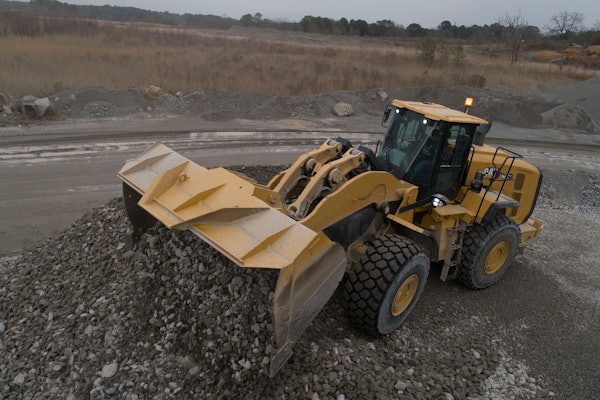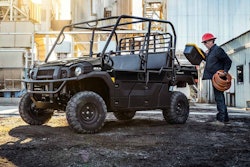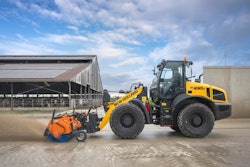Years ago if a government agency wanted to repair a deteriorating asphalt road, they had two choices – hide the problem with a superficial fix or tear it all out and throw the old material in a landfill. But with departments of transportation facing high traffic loads, skyrocketing material prices and tight budgets, disposal no longer makes sense.
Fortunately the asphalt recycling industry has created a variety of cost-effective, politically attractive road rehabilitation methods over the last three decades. The benefits of this technology are huge. Asphalt recycling reduces the amount of virgin aggregate and liquid asphalt used, and the cost, logistics and environmental impact of trucking this material to the paving site. It can quickly fix deteriorating pavements, including problems in the subgrade. Using recycling, the new road is often built to a spec that’s better than the original. The final wearing course can be something as minimal as a chip seal or as sturdy as a full layer of hot mix asphalt. Recycling can be used to expand lane widths or shoulders. And for DOTs under pressure to keep congestion to a minimum, most asphalt recycling methods allow the roadway to be opened back up to traffic soon after you park the equipment.
IS BLACK THE NEW GREEN?
The environmental success of recycled asphalt pavement is one of the best-kept secrets around. According to the U.S. Federal Highway Administration, some 73 million tons of asphalt is recycled every year and some 80 percent of the asphalt removed each year finds its way back into road construction. That makes asphalt pavement the most recycled product in the country. (See chart below.)
Recycling is always a good thing to do, but today it can also help you win bids. Project owners (including DOTs) in many areas of the country are being asked to develop LEED certification for their jobs and sites. (LEED stands for Leadership in Energy and Environmental Design.) Asphalt pavement recycling can play a big role in earning your customer LEED credits. The LEED program, put together by the U.S. Green Building Council, assigns credits for every environmentally positive step taken in the construction of residential and commercial projects. For more information go to: www.usgbc.org.
Choose your method
The Asphalt Recycling and Reclaiming Association has established five categories of asphalt recycling methods. These include:
- Cold planing
- Hot recycling
- Hot-in-place recycling
- Cold recycling (in-place and plant produced)
- Full-depth reclamation
In this article we’ll look at full depth reclamation (FDR) and cold in-place recycling (CIR). For definitions of the other types of asphalt recycling see the sidebar “Other asphalt recycling methods,” on page 32.
What CIR and FDR have in common is that both recycle 100 percent of the material and leave it directly behind the machine, thus eliminating material trucking costs. And for both, in many cases, a later application of a hot mix asphalt layer may be placed on top as a sealer or wearing surface.
CIR processes a specified depth of asphalt pavement. FDR cuts through the asphalt layers and incorporates a portion of the base material. Accordingly, specialized machines are used – a reclaimer/stabilizer for FDR and a milling machine for CIR.
The decision as to which method to use depends on what shape the road is in, the cost and availability of materials, the type of soil underneath the road and the engineer’s specs for the new roadway, says Larry Jack, director of marketing, Terex Roadbuilding. “If you catch the defects early, all the owner may need to do is a simple chipseal. At the next level it might require cold in-place recycling. But if water has drained down into the sub-base and gone through a freeze-thaw cycle or if there are defects in the sub-base, then the choice is usually going to be full depth reclamation,” he says.
There are a lot of different types of recycling, says Tim Kowalski, recycling product manager for Wirtgen America, especially when you consider the different types of emulsions and additives that are used to enhance the mix. Soil types and the design requirements of the road determine these. “All of them have their place, but there is not one type that’s best for all,” he says.
Successful recycling projects start long before the equipment is unloaded, says Steven Muncy, ARRA technical director. Proper distress identification and lab testing are key. By identifying the cause of the distress, the depth of treatment and process are selected. Material evaluation and mix design determine the additive.
Full-depth reclamation
Reclaimer/stabilizer machines use a large cutter drum studded with carbide tipped teeth to pulverize the asphalt, base materials and soil down to as deep as 16 or 20 inches. The grinding is done inside the drum cutter housing with the carbide teeth in most cases rotating in an upcut direction. (Manufacturers also offer downcut drums for specialized applications.) Plates or breaker bars inside the drum may also be added to the housing to further control the size of the graded material.
“It’s going to take all 16 inches, pulverizing the asphalt and mixing it with the base materials,” says Randy Kessler, senior service engineer, Caterpillar Paving. “In most cases the spec is to grind the asphalt pieces to 1.5 inches or smaller.”
The equipment train for FDR is fairly straightforward. In most cases you’ll have an additive spreader or pump truck up front being pushed by the reclaimer/stabilizer, which is followed by a compactor and motor grader and additional compactors. If the additive is placed on the material after it has been pulverized, the reclaimer/stabilizer will tow the spreader or pump truck. Over the years, reclamation projects have been trending toward deeper cuts with tighter specifications and manufacturers have responded with higher horsepower, four-wheel-drive reclaimer/stabilizers to get the job done quickly and cost efficiently, Jack says.
The material left in place is compacted and shaped by a motor grader to the desired road profile and then a final compaction is done to seal the surface. Initial compaction is usually done with a large vibratory roller, Kessler says, 25 tons or better, because the reclaimed layer is fairly deep. Padfoot rollers may be used if the layer is more than 6 inches deep. After shaping, the finish roller used may be smooth drum or pneumatic, depending on the engineering specs. The new, compacted material is generally more stable than a conventional subgrade due to its depth and the presence of the pulverized asphalt, which acts like additional aggregate in the road base. At this point the compacted recycled material is left to cure (if necessary) and then topped with a wear course.
In addition to the environmental advantages of FDR, this application also enables you to fix subgrade deficiencies, improve the structural properties of the subgrade and restore a deteriorated road’s slope and profile. FDR is also economical and can be accomplished with a relatively simple equipment train.
Cold in-place recycling
CIR uses a cold planer or modified milling machine to cut 2 to 4 inches into the existing asphalt layers. Typically an asphalt emulsion or an emulsified recycling agent is used as an adhesive. Chemical additives such as Portland cement, lime, kiln dust or fly ash may be used to enhance certain properties.
Standard milling machines are equipped with an up-cutting drum. In a single-unit CIR train milling machines are typically configured so the cutters rotate in a down-cutting direction, which can have a positive effect on material sizing. The additive is mixed with the RAP in the cutter drum housing, says Eric Baker, marketing manager at Roadtec. In a multi-unit CIR equipment train the RAP is placed by the milling machine’s conveyor into a separate mix paver with a pugmill and screed.
The multi-unit train is led by a large milling machine, which places the RAP into an intermediate screening and crushing unit to size the material and a pug mill to mix it with additive. Once it’s sized and mixed with the additive, the RAP is left behind in windrows and captured by a pickup machine to be fed into a conventional asphalt paver.
Having the mixing and sizing done by a separate unit that’s towed by the mill enables you to control the size of the rap better and gives you a more precise distribution of the additives Baker says.
The biggest advantage to CIR is value, Baker says. Typically you are rehabilitating 2 to 4 inches of the existing roadway with little more added than some oil and an overlay. This provides a much better end product than an overlay alone and is much less expensive than a mill- and-fill of the same depth, he says. Additionally the durability of a CIR pavement is just as good if not better than other methods.
Additives and emulsions
Although it is sometimes allowed under the right conditions, it’s rare that the recycled product left behind by a reclaimer/stabilizer or milling machine is sufficient by itself. To improve the mechanical properties of the recycled roadbed a variety of additives are introduced to the material. Once in place and compacted, some emulsions or additives need time to cure, anywhere from a few days to two weeks, before you can go back in and put down the final asphalt wear layer. But the surface can usually be opened to traffic immediately or shortly after compaction. In some cases traffic can actually help speed up the curing process.
“If you’re going to have a high traffic roadway, it’s probably going to be treated with an additive,” Jack says. These may include water, lime, calcium or magnesium chloride, fly ash, Portland cement (dry or in a wet slurry), asphalt emulsion, foamed asphalt or a combination of these.
Based on site conditions and lab testing, engineers determine what additives work best for a desired spec in each job, but the methods of application vary. The simplest way to get the additive into the mix is to spread it out as a dry powder in front of the reclaimer/stabilizer or milling machine. But many of these machines are also outfitted with liquid additive systems and computerized controls so you can meter the injected additive into the mixing housing directly from a pushed tanker truck. Liquid additives provide a more uniform coating of the recycled product and evenly distribute the slurry or additive in the mix. Slurries also will have the same positive impact on the soil while reducing the dust often associated with dry additives. Sometimes the additives are spread over the pulverized material after the first pass of the reclaimer/stabilizer and then worked into the recycled material with an additional pass.
“Lime and cement are mainly there to increase the fines content and help some in wet tensile strengths of certain materials,” says Kowalski. With foamed asphalt, hot asphalt oil is injected into an expansion chamber along with water and air. When the water and oil collide, they expand or foam and are pushed out of the expansion chamber into the mixing drum area. Once this expanded material hits the aggregate, the bubbles explode into millions of microscopic particles of asphalt that coat the fines in the mix. “It’s like little spot welds that hold everything together in the matrix. Once you foam the material and squeeze a handful of it, it looks like someone took a fine-tipped magic marker and put black dots all over your hand,” he says.
Getting the business
As with most road building jobs, there’s a political element involved in winning a bids for asphalt recycling jobs. “Be prepared to go through a couple of years marketing your company’s abilities to do this,” Jack says. “You may be asked to do some demonstration projects in order to show how the process meets the desired results.”
One big advantage you will have is that asphalt recycling offers substantial environmental benefits. Many government agencies strive to enhance their environmental credibility and asphalt recycling speaks directly to that need.
To be successful at these types of road recycling you have to bring together three elements, Jack says. “You can’t just do it by the seat of your pants,” he says. “You have to have an entrepreneurial spirit and the will to succeed. You have to have the engineering input and understand the capabilities and different types of asphalt recycling and how they apply to conditions in your area. And third, the manufacturer’s equipment you choose has to be the right design and set up for the job. Put all three of these together and you will succeed.”
Jack also mentions that contractors who join ARRA have access to a wealth of experience and technical expertise from the organization-people who basically wrote the book on asphalt recycling and reclamation. The association has been promoting the industry and working with manufacturers and contractors to improved the techniques and technology for more than 30 years. You can find out more at www.arra.org.
Other asphalt recycling methods
In addition to full depth reclamation and cold in-place recycling, the Asphalt Recycling and Reclaiming Association lists several other methods. These include:
Cold planing. Cold planing is the controlled cold milling of pavement to restore the surface to a specified profile. Bumps, ruts and other surface irregularities are removed, leaving a uniform textured surface.
Hot recycling. Here the RAP is combined with virgin aggregates and heated in modified batch or drum mix plants. According to ARRA, hot recycling is the most widely used asphalt recycling method in the world.
Hot in-place recycling. Hot in-place recycling is an on-site, in-place method that rehabilitates deteriorated bituminous pavements and minimizes the use of new materials. This process may be performed as either a single pass (one phase) operation that monolithically recombines the restored pavement with virgin material, or as a two pass procedure, where the restored material is recompacted and the application of the new wearing surface then follows a prescribed interim period that separates the process into two distinct phases.
Cold central plant recycling. This subset of cold recycling uses a stationary cold-mix plant to produce a mix that can be used immediately or stockpiled for later use. This process is selected when the project will not accommodate in-place methods or there is an existing RAP stockpile. Many CCPR plants are portable and set up near the job, eliminating the need for asphalt plant permits.
Facts About RAP
If all the asphalt pavement that is reclaimed every year were put in one cone-shaped stockpile it would measure 759 feet high and 1,298 feet wide. By comparison the Washington Monument is 555 feet high.









